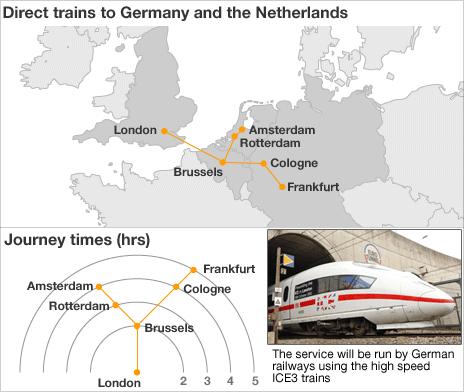German rail firm DB competes for Channel Tunnel routes
- Published
Deutsche Bahn is hoping to set up services between London and cities in Germany.
German train operator Deutsche Bahn says it will run direct services from London to Frankfurt and Amsterdam from 2013.
A train similar to the ones to be used will be displayed at London St Pancras station on Tuesday.
Three services will run daily, and will also serve Brussels, Cologne and Rotterdam.
DB must get approval for its trains from safety authorities before services can run but is confident of doing so.
At the moment the only passenger train services through the Channel Tunnel are run by Eurostar.
Train split
But Eurotunnel - which sells tunnel access to train companies - says that overall there is still around 50% spare capacity.
The German company wants to run services direct between London and the continent three times a day.
Trains would leave London, travel to Brussels and then split.
One half of the train would go on to Amsterdam via Rotterdam, with the other half travelling to Frankfurt via Cologne.
The trains would be capable of travelling at 200mph.
It is expected the journey to Amsterdam would be around four hours, with Frankfurt around five hours away.

They would be modified to allow passengers to check travel and connecting services information at their destinations in real time.
Escape tunnels
But in order to be allowed to run services through the tunnel, Deutsche Bahn needs approval from the Channel Tunnel Intergovernmental Commission.
The operator needs to demonstrate to the commission that its trains are safe for use in the tunnel.

There are some differences between the Eurostar and Deutsche Bahn carriages
One step towards this was taken in the early hours of Sunday morning, when Deutsche Bahn carried out evacuation tests with one of its trains.
The company needs to show it can get passengers safely into the Channel Tunnel's service tunnel in the event of an emergency.
Passages to the service tunnel are placed every 375m, which means a 400m Eurostar train can position itself so passengers can get off either end and immediately access the escape route.
The ICE 3 trains are each 200m long and two of them would be joined together for the journey through the tunnel.
But unlike the Eurostar services, this joining means passengers cannot walk through carriages from one end of the train to the other.
Deutsche Bahn has been testing a variety of different scenarios to try to demonstrate that passengers can still get to the escape tunnels safely.
Power issues
Another problem is rules over how the trains generate their power. Eurostar services have dedicated power cars at either end.
But the new trains, which Eurostar has also ordered for its own services, have the power units spread out, with smaller motors positioned by the wheels along the train.
This has the advantage of freeing up more space for passengers and has been approved in principle by the authorities, but still needs approving on an individual basis for this particular train.
Deutsche Bahn argues that its move could be the start of a new phase for the Channel Tunnel, with other operators following its lead and offering more direct services from London to other countries.
A Deutsche Bahn ICE 3 inter-city express train arrives at London St Pancras